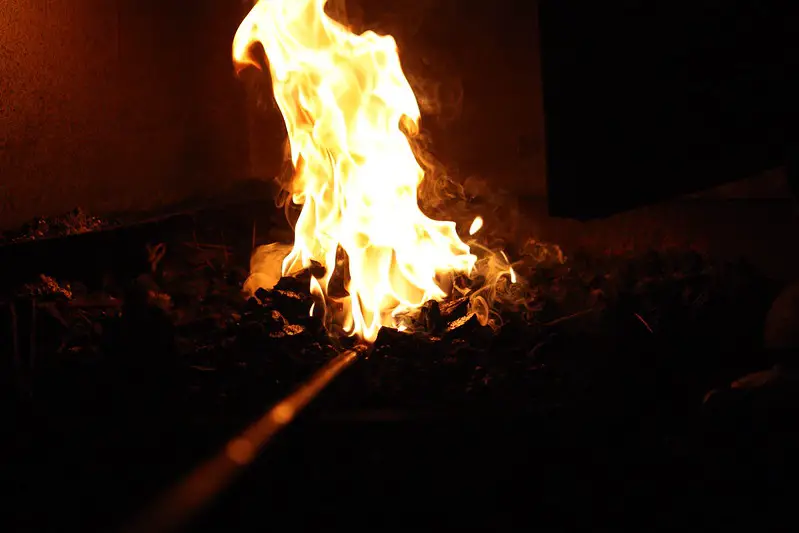
What is a blacksmith forge? It’s a “hearth” for a very hot fire that is used to heat up steel. At its heart, forging is a pretty simple process: heat up some metal, and hit it with a hammer. Despite its simplicity, many newer smiths tend to get tripped up when it comes to deciding what kind of forge to buy.
I will often recommend new smiths begin with a JABOD (just a box of dirt) forge, not because it’s the best forge – it’s actually pretty suboptimal – but because these forges illustrate just how little equipment is needed to begin smithing. These types of forges are quick and easy to make yourself…
But many of you are busy people with day jobs, and while manufacturing your own forge can be fun, it can also seem like an unwanted burden to people who just want to begin hammering iron as soon as possible.
For many new smiths, it can be worthwhile to buy a ready made solution that will allow you to hit the ground running. These pre-built forges will allow you to get some shop time; this shop time will in turn provide valuable information about your own unique preferences and needs while smithing. You can use this feedback to customize or build your own forge to fit your own personal needs.
I guess what I’m trying to say, is that it’s a mistake to try and worry about the “perfect forge” when you are new to the craft…you may not even have enough experience to know what you like yet! So don’t overthink it.
Buying a prebuilt forge is a great way to quickly begin your smithing journey.
So which forge should you buy? There are many different types of forges, all of them with unique pro’s and con’s. While there are many different types of forges, I will try and go over some of the most common ones below.
Types Of Blacksmith Forges
There are 3 major types of blacksmiths forges. They are solid fuel forges, gas forges, and induction forges. The vast majority of forges you will see for sale will be one of these 3.
Solid Fuel Forge
The solid fuel forge is the “classic” forge. These forges work by providing air flow to a combustible material such as coal,charcoal, or coke.This type of forge typically consists of a few parts:
Parts Of A Solid Fuel Forge
- A hearth/fire pot to store the fuel
- An air source, this can be a bellow, or any type of electric blower
- A tuyere or pipe that delivers fresh air to the fire
- A gate that allows you to easily dispose of ash and waste byproduct
- Some advance forge designs will have a gate that lets more or less air from the blower, this allows you to more readily control your heat.
- an exhaust hood or some other mechanism for channeling smoke away from your lungs
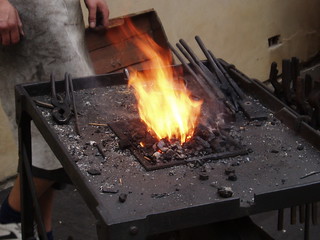
A simple solid forge setup with a firepot. Image source - Most everyday blacksmiths don’t use this, but some more enterprising fellows will have a thermometer of one sort or another on their forge. Choosing the right thermometer is an entire article in itself, so I won’t go into details for now. These tools are useful for maintaining a consistent production environment.
- Some forge designs will have refractory bricks in between the fire and the steel frame in order to prolong the life of the steel frame.
Pro’s Of A Solid Fuel forge
- Easy to make, cheap to buy
- The de facto choice for historical reenactors
- Simple to understand and modify
- Can get to high temperatures easily
- Easy to forge weld with sufficient airflow.
- Can deal with large and unwieldy projects more easily than propane or induction forges
- There are many designs, but all are pretty similar and easy to understand
Con’s Of A Solid Fuel Forge
- It takes a bit of work to make them portable
- Burning fuel is not great for your lungs and can annoy your neighbors
- Can be stinky depending on the fuel source used
- It can take awhile to get the forge going
- The pile of fuel in the fire pot will need to be maintained as you work – some people like this and count it as a pro
- Takes some effort to get long pieces to heat consistently across the stock.
Solid fuel forges are a great way to get started with blacksmithing, it’s how I got started and you really can’t go wrong. If you are looking for an in-depth guide that goes over the pro’s and con’s of all the different types of forge fuels, check out my guide on blacksmith forge fuels
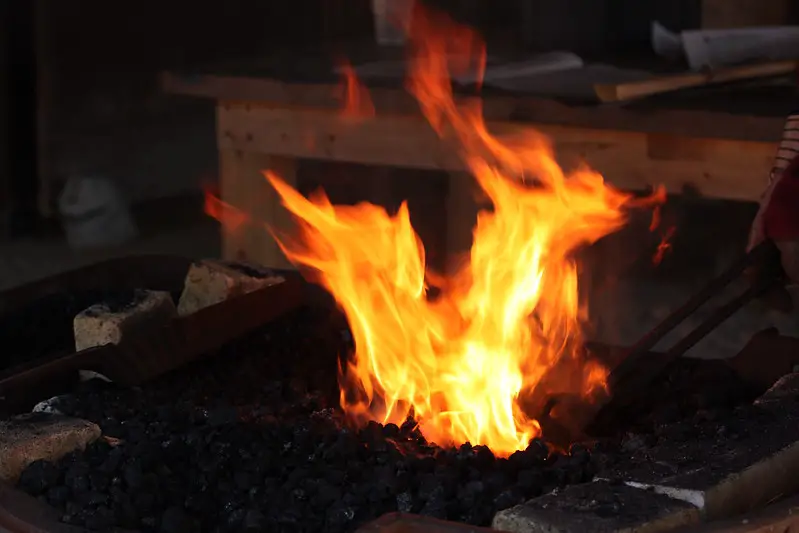
Gas / Propane Forge
While propane forges are not good for historical purposes, they are incredibly practical and great for your average blacksmith who may be stuck in a suburban environment or may not have a lot of workshop space to devote to the craft. Gas forges are easy to setup and put away, are relatively portable, and don’t take up a lot of space in the shop. Once you have your propane forge setup properly, it can provide remarkably consistent heat, which is great for projects requiring more precision. These forges are also much much cleaner than solid fuel forges.
Like anything in life, there are tradeoffs and propane forges do have some downsides. For starters, they are incredibly noisy, and hearing protection is required. It can be difficult to get sloppily built single burner propane forges to welding heat, and they can be a bit fragile. Flux that is the result of regular forge welding work will melt right through the insulation material in most propane forges. If you are not careful you can significantly reduce the lifespan of your forge by being sloppy with flux.
Pro’s of a propane forge
- Clean Compared To Solid Fuel Forges
- Easy To Setup And Put Away
- Consistant Heating Temperature
- Space Efficient
- Can Be Made More Powerful By Adding Additional Burners
Con’s of a propane forge
- Noisy
- Poorly Constructed Propane Forges May Struggle To Reach Welding Heat
- Insulation Material Is Easily Destroyed By Flux
- Insulation Material Is Harmful To The Human Body
Induction Forge
Induction forges are really freaking cool, but they are expensive. An induction forgue heats up metal without touching it through electromagnetic induction. They are nice because they don’t create environmentally harmful byproducts, and they allow you to have much more control over your heating process. This is great for larger production runs as you can have a more consistent manufacturing process and a more consistent product as an end result.
I will review some induction forges later on, but I will focus more on solid fuel forges and gas forges as they are about ½ – ⅓ the price of the cheapest induction forges. I would only recommend one of these forges if you are a business or a very environmentally conscious person.
Pro’s of an induction forge
- Heating up a piece of steel with an induction forge is significantly faster than with a gas or solid fuel forge. You will be able to do more work in less time, and your arms will get bigger as an added bonus : ).
- Much less likely to disturb neighbors, no smoke, no smell, ventilation is much easier to handle.
Con’s of an induction forge
- Big or irregular pieces don’t work well, may not be a great option for artists who routinely do big or unusually shaped pieces.
- Expensive $$$
- Require A Lot Of Technical Knowledge To Modify Safely
- Must have an electrical setup that can support it.
Best Blacksmith Forges For Sale (Review / Guide)
If you are not interested in all the options available and just want my top pick for the best blacksmith forge for sale, my pick would be the hellfire double burner portable propane forge. This forge offers the best bang for the buck and with two burners should be able to handle most of your blacksmithing needs. Unlike solid fuel forges, this forge will be up to working temperature within about 10 minutes, which makes it much easier to do one off projects in the afternoons or on the weekends. This product is easy to assemble and is made with a consistent quality, I mean just look at the reviews!
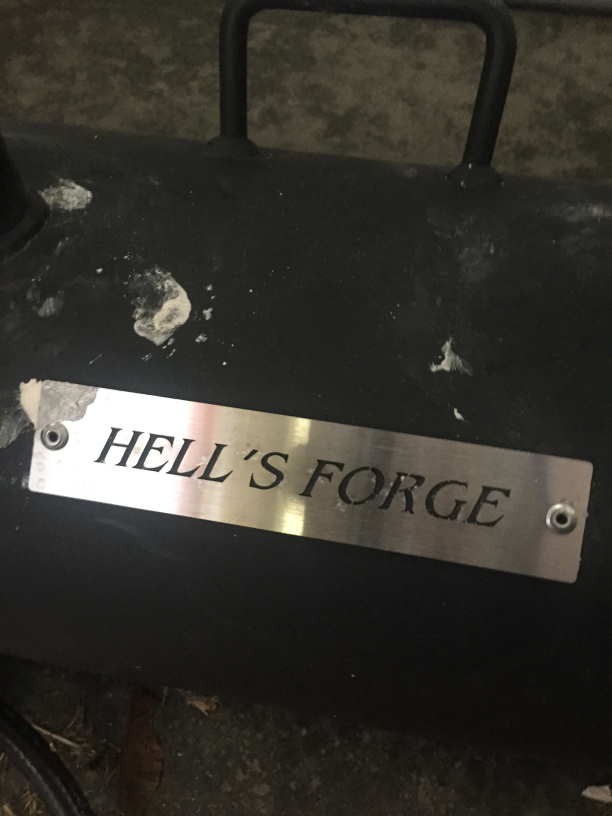
This forge is capable of reaching 2300 degrees Fahrenheit and comes with a container of HELLCOAT 3000 refractory coating which will ensure longevity under high temperatures. Another thing I like about this particular forge is that it comes with two thick fire bricks for the bottom of your forge. These bricks will help protect your forge from damage, especially from flux and slag.
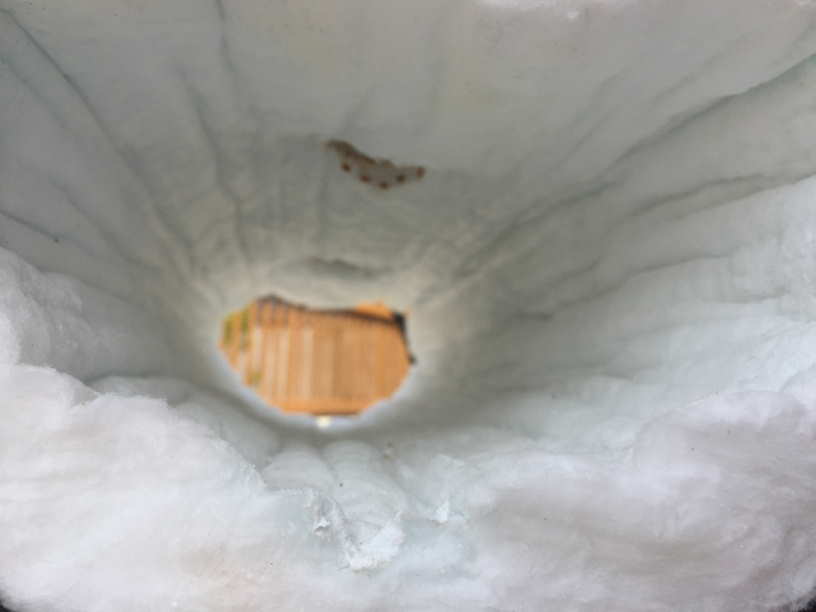
It’s relatively cheap, easy to assemble, and will get you started on your blacksmithing journey, there really isn’t too much else to say! Get yours -> here.
Best Solid Fuel / Coal Blacksmith Forge For Sale
So if you are looking to buy a solid fuel forge you have 2 options on amazon at the moment. The first is to buy a fire pot and blower separately and then assemble them however you see fit. The second option is to buy a forge that comes with all the parts you need but may not have all the bells and whistles you would like. I will go over both options briefly.
The first option involves buying a firepot, I recommend the 10” x 12” x 5” fire pot manufactured by Simond Store. This is a sturdy firepot weighing in at 44lbs and should last you a good long while. I like this firepot as the ash gate and the tuyere port are already built into the fire pot – some fire pots for sale are JUST the pot, and you have weld other parts onto it….a PITA in my option.
After that all you need is a table for the pot, and a blower. If you want a blower that is sturdy and can withstand the stress of your forge, I recommend the Sunlar 110V 250W electric blacksmith forge blower. This blower has 4mm thick advanced aluminum material protecting the blower, and will last longer than flimsy plastic blowers.
If you don’t feel like putting all that together and want an easy to assemble solid fuel forge, another great alternative is this forge manufactured by whitlox.
It ships in 4 boxes, and is pretty easy to setup. The only thing I don’t like about it is that ashe will accumulate during long smithing sessions, and the cleanup will always be a bit of a mess. Other than that it’s a solid forge and has all the pieces you need so you don’t have to shop around for a bunch of disparate pieces.
Best Propane Blacksmith Forge For Sale
I already mentioned the Hell’s forge two burner forge as my top blacksmithing forge pick, but a good runner up is a single burner forge made by the same company.If you are super budget conscious or are absolutely 100% sure that you won’t be working on larger projects, this is a good small propane forge.
It has 1” ceramic fiber blanket on the inside of the forge and comes with an additional refractory paste that is applied by the user. Like the double burner posted above, this forge comes with a thick firebrick at the base of the forge to further protect your insulation blanket.
Best Induction Blacksmith Forge For Sale
I want to admit up front, I have never personally used an induction forge. I think they are cool, and I think I will buy one in the future, but I can’t claim any expertise on the matter (maybe I’ll do a little research and do a write up on them in the future). But they are worth mentioning anyways as they can heat up a piece of stock to a white hot temperature in a VERY short time period. They do this without the headaches involved in burning fuel. I’m coming to believe they are an option that should be taken seriously if you have the money for it.
If you are thinking of buying an induction forge, I would check out this model by happy buy.
Cheap Blacksmith Forge
The cheapest blacksmith forge that I can think of is JABOD forge as was mentioned in the beginning of the article. These forges are super simple to make: just make a big box and cut a hole for your tuyere in the side. Stick one end of a black pipe in that hole after removing the paint on the pipe and then hook it up to an air source. Easy peasy. These forges do however have drawbacks, you can’t drain the ashes easily, they take a lot of work to cleanup, and you will also probably want to make a stand for them. I still think it’s easier to just buy a propane forge as is mentioned above.
Best Portable Blacksmith Forge
Portability is important for blacksmiths that are on the go. Once again I”m going to have to recommend the double burner propane forge from up above. Unless you are doing a competition or something where an even quicker heat up time is necessary, that forge should serve all your needs while being easily portable.
Source for title image